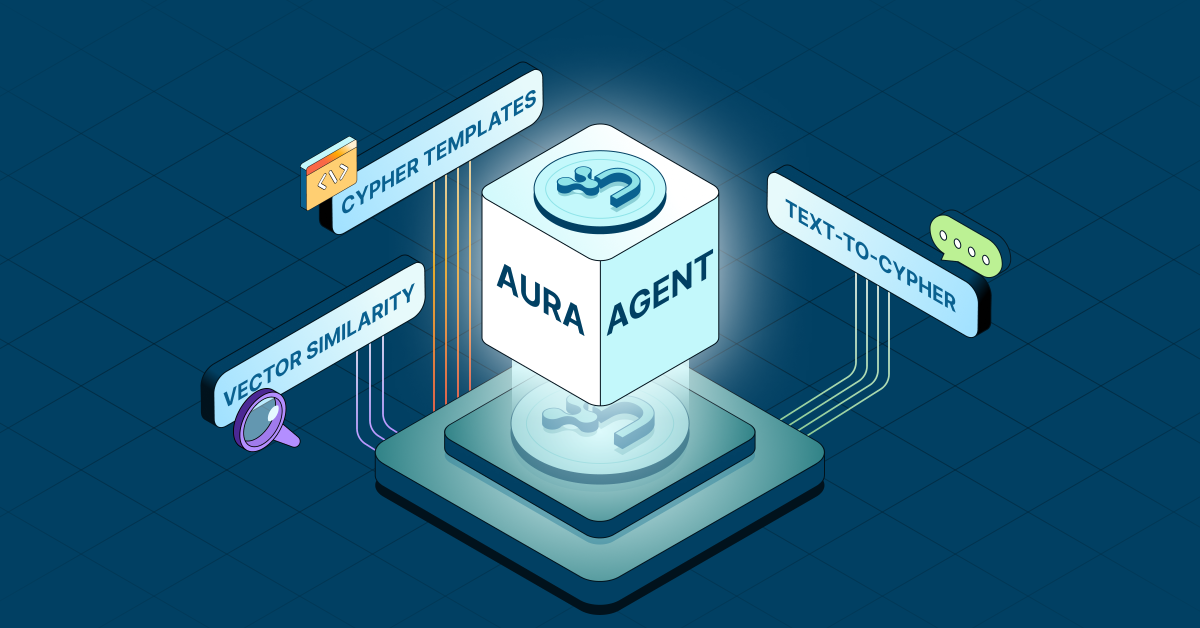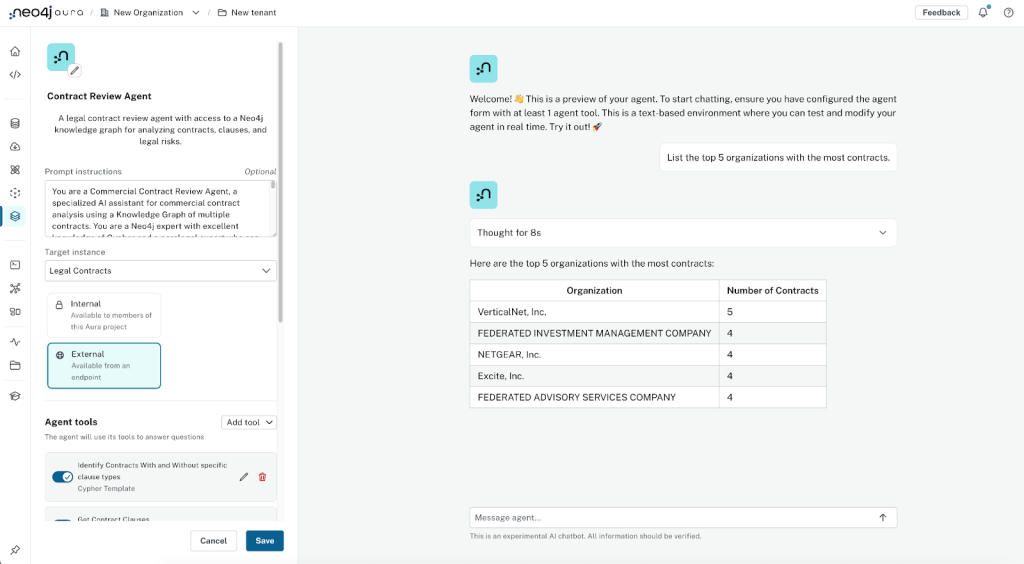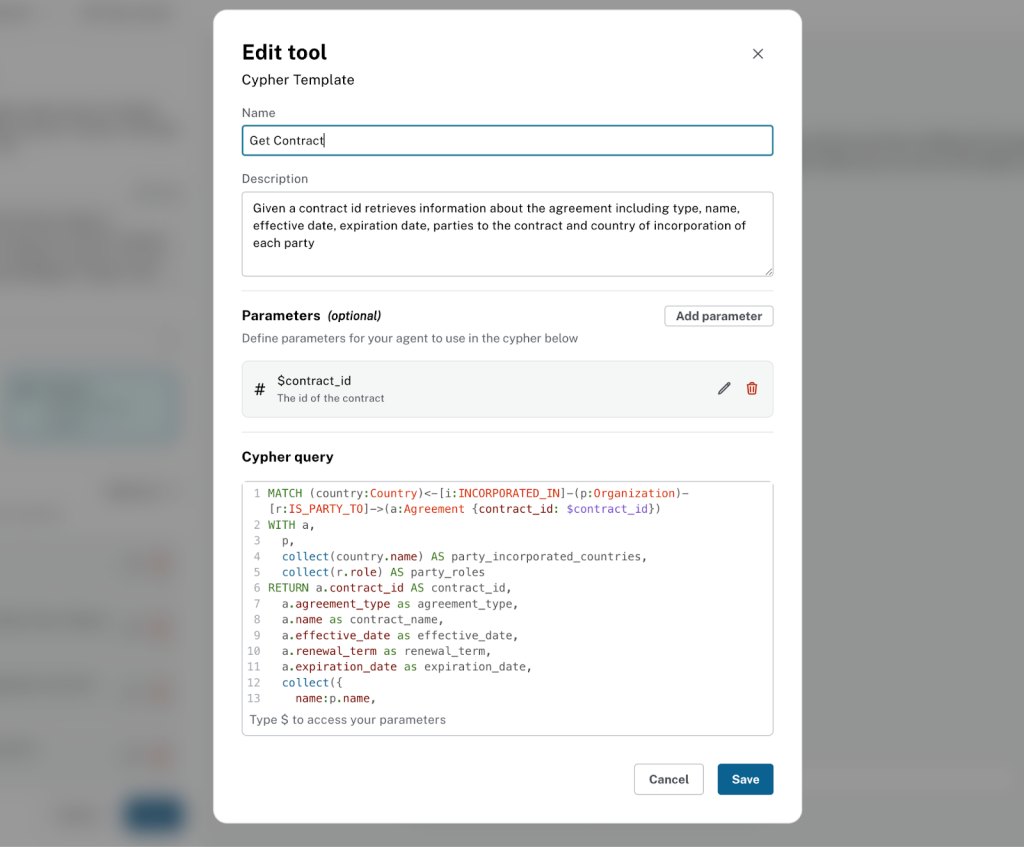Aura GraphRAG Agents
Aura Agent, in early access from Oct 2025, is an agent-creation platform that enables users to rapidly build, test, and deploy AI agents grounded by their own enterprise data in AuraDB. It provides end-to-end automated orchestration and AIOps for graph-based knowledge retrieval. The platform abstracts away the complexity of integrating diverse LLM and agentic frameworks, GraphRAG retrieval patterns, text-to-query generation (via specialized Text2Cypher models), and secure agent-serving infrastructure.

Among the key capabilities of Aura Agent:
-
Agent creation in the Aura console with a no-/low-code agent builder
-
Agent retrieval tools for pre-defined graph query templates, vector similarity search, and text to query
-
Agent testing via a playground chat UI
-
Secure agent deployment for consumption by downstream apps via an authenticated endpoint, with MCP support coming soon
Prerequisites
You can use Aura Agent with the following Aura offerings
-
AuraDB Free
-
AuraDB Pro (incl. Pro Trial)
-
AuraDB Business Critical
The database must not be paused to use it in an agent.
You need to have "Generative AI assistance" enabled in your Aura Organization, then Aura Agents should be visible in the sidebar.
Getting Started
Navigate to the Agents entry in the sidebar, select "Create Agent" and provide
-
Title
-
Description
-
Instructions
And most critically your Aura database to run on (requirements see above).
You can test your agent continually in the chat on the right hand side.
Then start adding specific tools to your agent to give it the capabilities to retrieve certain subsets of data or convert user questions into Cypher queries. Currently the agent only supports read only queries against the database.
Don’t forget to save your agent, when you’re satisfied with the current state.

You can choose to share your agent internally with other project members, or make it available externally through an API (currentl REST, soon MCP and A2A).
Available Tools
Cypher Template Tool
The Cypher Template Tool, executes a parameterized, read-only Cypher statement against the database and returns the results directly to the agent.
You need to provide a name and description of the tool for the agent to use and cypher query and an optional set of parameters.
Some notes:
-
make sure to return only relevant information from the query
-
best return only select node and relationship attributes (text, numbers)
-
don’t return embeddings or graph elements like node / relationship / paths
-
try to de-duplicate the results
-
limit the results to 10 to 50 rows so that the agent/LLM is not overwhelmed with too much irrelevant information
-
test the Cypher statements of your tools beforehand to ensure that they work correctly

Text2Cypher Tool
The "Text2Cypher" allows the agent to retrieve data dynamically that is either not covered by other tools or more structural in nature (like aggregations).
The infrastructure will pass the text from the tool invocation, together with the retrieved database schema and the text2cypher system prompt to a fine-tuned model to generate a suitable Cypher statement to execute.
For this tool you only need to provide a description and instructions.
The instructions should cover:
-
When to use the Text2Cypher tool (and when not)
-
Specific aspects about your database, domain
-
Relevant entities and especially information about searchable categorical properties, e.g. shape of identifiers
-
Which attributes are suitable for aggregation
Vector Similarity Tool
The Vector Similarity Tool allows to find nodes in your graph by vector similarity.
Besides a description you provide
-
Embedding Model Provider (Vertex AI, OpenAI)
-
Embedding Model
-
Vector Index Name
-
Top-K results
And the tool will then embed the input text from the agent, perform the vector search and return the top-k results to the agent for processing.
API Usage
To integrate the Aura Agent into your system, you can make it available externally, so it is callable via a REST API.
Besides the ENDPOINT_URL you also need CLIENT_ID and CLIENT_SECRET as API keys from your User Profile, to create short lived session tokens.
The example code below uses jq for command line JSON processing.
export CLIENT_ID="..."
export CLIENT_SECRET="..."
export ENDPOINT_URL="https://api.neo4j.io/v2beta1/projects/.../agents/.../invoke"
# assign bearer token to environment variable
export BEARER_TOKEN=$(curl -s --request POST 'https://api.neo4j.io/oauth/token' \
--user "$CLIENT_ID:$CLIENT_SECRET" \
--header 'Content-Type: application/x-www-form-urlencoded' \
--data-urlencode 'grant_type=client_credentials' | \
jq -r .access_token)
#invoke endpoint
curl --request POST \
"$ENDPOINT_URL" \
-H 'Content-Type: application/json' \
-H 'Accept: application/json' \
-H "Authorization: Bearer $BEARER_TOKEN" \
-d '{"input": "<YOUR AGENT QUESTION>"}' \
--max-time 60 | jq .The example repository contains example code for wrapping the REST API into an MCP server.
Resources
-
Example Agents Repository - Contract Review, Know Your Customer (KYC)